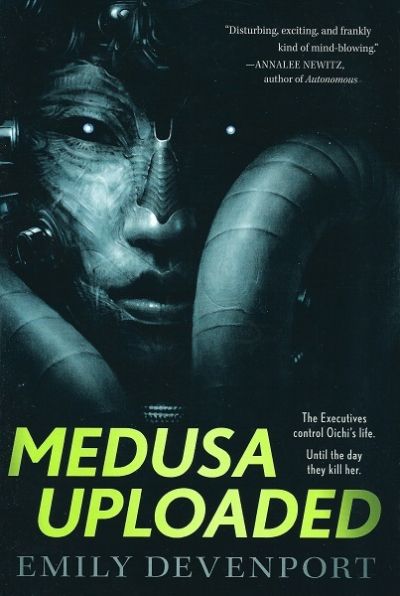Inciting and Inviting Me
Medusa Uploaded (Medusa Cycle, volume 1)
By Emily Devenport

23 Jul, 2019
Emily Devenport’s Medusa Uploaded is the first volume in her generation ship series, the Medusa Cycle.
Olympia and Titania are two vast generation ships, dispatched on a long, slow journey to another star system. This was lifetimes ago. Olympia is still functioning, but poor Titania is lifeless wreckage tumbling across the stars, the victim of an act of sabotage. Oichi was born on Titania but was fortunate enough to emigrate to Olympia before Titania’s destruction. The rest of her family was not so lucky.
Oichi isn’t one of the ruling Executives; she’s a so-called worm. Her lot is to work hard for her whole life, hoping that no Executive will order her tossed out an airlock. Oichi’s fortune turns sour. Suspected as a potential dissident, she is cast out into the interstellar cold.
This is not the end of her story.
Although the Executive do their best to root out and annihilate dissidence, Oichi’s parents managed to implant Oichi with technology the Executives had tried to suppress (because it would allow worms to defy the oligarchs). The tech gives Oichi control of all her senses; this allows her to interface with an AI, a Medusa. Thanks to the Medusa, the enhanced Oichi survives the vacuum of space.
Oichi had been given a worm’s eye view of Olympia’s vicious, hierarchical society. Oichi knows that the Executives will resist any open attempts to reform the system. Oichi takes a different path. She pits the Executives against each other. Their lives may look like ease and luxury to the worms, but every Executive knows that life is an endless Hobbesian struggle. It’s each family against all others; it’s families divided against themselves. Powerful Executives victimize weaker ones. Even the powerful fear that their grasp on power will slip. It is a social arrangement that is exquisitely vulnerable to the machinations of a well-placed, enhanced ghost.
Oichi has high-level access to Executive computer systems, access she uses in her campaign of terror. She murders Executive after Executive. Her victims are chosen to exacerbate struggles. She can change her appearance; she abandons old identities as soon as they’ve served their purpose. She would seem to be unstoppable.
Not so fast. Raised as a worm, Oichi was taught a highly edited, perhaps entirely fictional version of history. Her enhancements mean she can read all Executive files, but lacking context, she does not always understand what is actually going on within Olympia. There are factions of whom Oichi knows nothing, factions whose agents are just as deadly as Oichi.
She must learn fast or die.
~oOo~
Oichi spends most of the book playing in god mode, which does tend to undermine the tension somewhat, at least until she encounters other players whose godmode is more godlike than hers. Still, who wouldn’t like a pleasant fairy tale about booting oligarchs into space, or better yet, getting them to do that to each other?
Oichi’s world is riddled with references to Homeworld history up the 20th century — and nothing afterward. She has learned about some cultures — but not all. Ordinarily, I would complain (yet again) about science fiction’s weird cultural blind spots1. In this case, it seems likely that the people who built the two ships deliberately created a simplified and quite possibly entirely untrue history, a lie to be taught to the worms. Oichi learns the truth of the matter (or some of it) towards the end of novel.
The people on board the ships have been told the usual story about how their curiously unnamed Homeworld was destroyed. They are the last of their people. This is the setting for many generation ship epics, and implausible space westerns. One of the more thoughtful characters in the novel points out that this story makes no sense at all. Cultures in the process of collapse don’t built mountain-sized spacecraft able to bridge the gap between stars in only a few lifetimes2. The ships themselves are evidence of a sophisticated, developed civilization; the tale of Homeworld’s death is bogus.
Oichi’s voice is very engaging. The narrative moved fast, carrying me with it. By the end of the novel, All Has Been Explained … or perhaps More Than We Knew At the Beginning Has Been Explained. I wasn’t sure that it had been completely explained. Nor did I think that Oichi’s actions, or those of the hidden factions, made complete sense. Presumably all this will be sorted out in the next book.
Medusa Uploaded is available here (Amazon), here (Amazon) and here (Chapters-Indigo).
1: Such as an SF novel set in the 21st century in which SF was said to be vibrant and alive … but all of the authors mentioned were ones who would have been familiar to readers in the 1990s.
2: The shipbuilders appear to have gone for over-engineering. Oichi thinks the ships could survive a trip across the galaxy. Not that being wildly over-engineered helps against maliciously emplaced WMDs.
(Oichi also thinks that such a trip might take long enough that Andromeda would be colliding with the Milky Way. That time frame is impossible to reconcile with getting from one star to another in a couple of centuries. Oichi isn’t a reliable narrator.)
